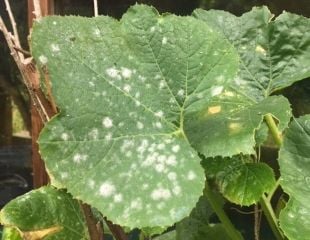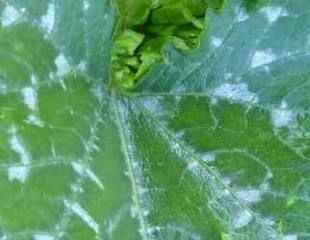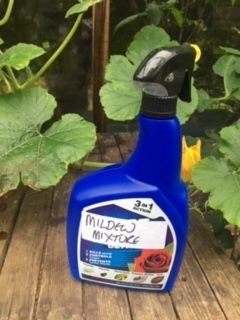


What to do about Powdery Mildew on Courgettes, squashes and Cucumbers

Powdery Mildew is a common disease of all cucurbits, which means it affects squashes, cucumbers and Courgettes.
Powdery mildew appears on the leaves as white patches, or spots. Powdery mildew can cause white patches all over the leaves. The image left is a good example of a significant powdery mildew infestation, and potentially, if left unchecked, it can damage the plant and reduce yields. The leaf has soft white patches on it.
Powdery mildew looks different to courgette mosaic virus, illustrated in the centre.
Powdery Mildew is more common in warm environments with high humidity. Plants grown in a greenhouse are more likely to suffer from powdery mildew.
When powdery mildew strikes, one of the first steps is to improve air flow which can include moving plants outside or spacing out their containers. I did this recently to combat mildew and moved 80% of squashes and courgettes outside, some in containers and some I planted in the veg plot.
Here you need to recall that some cucumbers, plants and seed are sold as "outside" and some "indoor" varieties, the latter will have to remain in the greenhouse, irrespective of the powdery mildew. If you plant or place the courgettes and squash outside, ensure lots of space for air to circulate.
Next, remove the worst affected leaves and dispose of them. If you use pruning shears or any tools, disinfect them to prevent cross contamination.
Organic Spray recipe to beat Powdery Mildew

The next step is to spray the affected plants with an organic mix, which works surprisingly well.
Mix up a jug of about 1/2 pint or 250mils of milk, and milk powder works just as well as fresh. Dilute with water, various formulae are suggested around 50:50 or 60:40 works well. It need not be precise. Add 3 teaspoons of baking powder and a squirt of washing up liquid and mix well.
To apply it, use a water spray, or an old plant spray such as illustrated which had rose clear in it, throughly washed out. It recycles the bottle spray and works efficiently. Spray all affected plants thoroughly and repeat throughout the growing season.
After 2/3 applications you will see a significant improvement and the plants picking up and throwing off, to a large extent although not completely, the mildew infestation. The greenhouse may smell a bit milky, but a small price to pay. Ideally spray before the infection gets a hold. Continue to spray weekly.
